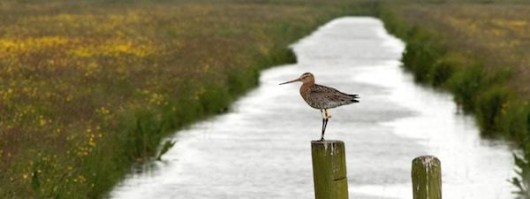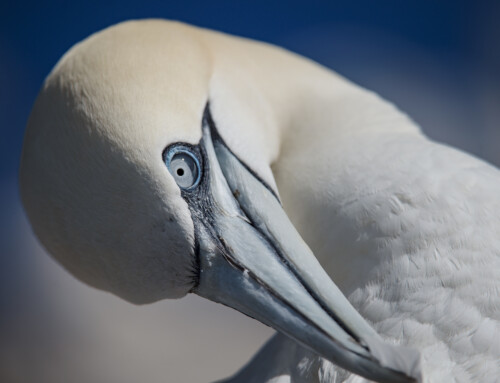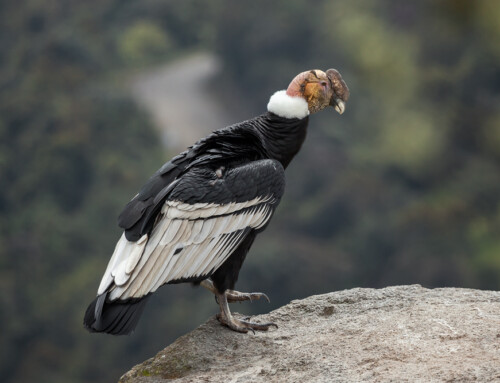Even when protected from mowing machines, success of Black-tailed Godwit nests is lower on grassland monocultures than on herb-rich meadows.
LINKED PAPER
Management of modern agricultural landscapes increases nest predation rates in Black-tailed Godwits Limosa limosa. Kentie, R., Both, C., Hooijmeijer, J.C.E.W. & Piersma, T. 2015. IBIS 157: 614-625. DOI: 10.1111/ibi.12273
For a long time Dutch grasslands offered exactly what Black-tailed Godwits needed: safe breeding grounds to raise their young. However, changing agricultural practices have transformed these habitats into monocultures where godwit nests are at risk of destruction from mowing. Does protecting nests from mowing improve godwit nest success?
The number of breeding pairs of Black-tailed Godwit in the Netherlands during the last forty years plummeted from 120,000 to fewer than 35,000 (see the latest index). Economic pressures on farmers to increase productivity have led to a transformation of herb-rich meadows into well-drained grassland monocultures, where grass can be harvested earlier and more frequently (Groen et al. 2012). The result is that fields nowadays are mown during the incubation phase of the godwits.

On grassland monocultures, it often happens that the grass is mown while nests of godwits, and other birds, are present. In our study area in southwest Friesland, in the majority of cases the nests were saved from destruction because local volunteers, ourselves, or in some cases the farmers involved, marked the nests with a stick. Farmers could then mow around them, an act which is, by the way, also subsidized by the government through agri-environmental schemes. However, although saved from mowing machines, the success rate of these nests decreased from 42% on an unmown monoculture to 32% when a large patch (often around 50 m2) of grass was left around the nest, to a staggeringly low 21% when a small (Kentie et al. 2015).

A small patch of grass in a mown field stands out and the nest in this patch is easy to find. Godwits were not more likely to abandon these nests. Therefore, increased predation rate seem to have caused lower hatching success on mown fields. Actually, some of the godwits had better abandoned their nests, as we sometimes found dead adult godwits lying next to them. These dead godwits tended to show the bite marks of foxes and stoats in their necks, but also the bite marks of farm dogs that are common in our study area. Was the breeding adult surprised by the predator, or did he/she erroneously trust the concealment of its nest?
Nests on herb-rich meadows had a higher success rate (56%) than nests on grassland monocultures. Herb-rich meadows are often especially managed for grassland-breeding birds, and in particular for godwits. Here, mowing is usually postponed until after 15 June, a time when the majority of eggs have hatched. Because Red Foxes colonized this meadow landscape only from 1990, and as densities of other predators have increased as well, increased predator numbers are often suggested to have been the main cause of declining meadow bird populations. However, our nest success rates on herb-rich meadows were comparable to those measured in the early 1980s by Beintema & Müskens (1987). This suggests that increased predator numbers form a threat only if the quality of the habitat is low.

Herb-rich meadows are not only important for higher nest success, chicks hatched here have a higher survival chance as well (Kentie et al. 2013). Godwit chicks leave the nest within 24 hours after hatching, after which they have to search for insect prey themselves, accompanied by their watchful parents. A mown field has no cover and fewer insects, and chicks become more vulnerable to predators (Schekkerman et al. 2008, 2009). To protect Black-tailed Godwits from further declines, we must seek good economic incentives to re-create and maintain much bigger areas of herb-rich meadows.
A colour-ringed Black-tailed Godwit is standing on guard in a herb-rich meadow area
© Rosemarie Kentie
Follow our Black-tailed Godwits on migration!
References and further reading
Beintema, A.J. & Müskens, G.J.D.M. (1987) Nesting success of birds breeding in Dutch agricultural grasslands. Journal of Applied Ecology 24, 743-758. View.
Groen, N.M., Kentie, R., de Goeij, P., Verheijen, B., Hooijmeijer, J.C.E.W. & Piersma, T. (2012) A modern landscape ecology of Black-tailed Godwits: habitat selection in southwest Friesland, The Netherlands. Ardea 100, 19-28. View.
Kentie, R., Hooijmeijer, J.C.E.W., Trimbos, K.B., Groen, N.M. & Piersma, T. (2013) Intensified agricultural use of grasslands reduces growth and survival of precocial shorebird chicks. Journal of Applied Ecology 50, 243-251. View.
Kentie, R., Both, C., Hooijmeijer, J.C.E.W. & Piersma, T. (2014) Age-dependent dispersal and habitat choice in Black-tailed Godwits (Limosa l. limosa) across a mosaic of traditional and modern grassland habitats. Journal of Avian Biology 45, 396-405. View.
Kentie, R., Both, C., Hooijmeijer, J.C.E.W. & Piersma, T. (2015) Management of modern agricultural landscapes increases nest predation rates in Black-tailed Godwits (Limosa limosa limosa). Ibis 157, 614-625. View.
Kentie, R. (2015) Spatial demography of black-tailed godwits. Metapopulation dynamics in a fragmented agricultural landscape. PhD, University of Groningen. View.
Schekkerman, H., Teunissen, W. & Oosterveld, E. (2008) The effect of mosaic management on the demography of black-tailed godwit Limosa limosa on farmland. Journal of Applied Ecology 45, 1067-1075. View.
Schekkerman, H., Teunissen, W.A. & Oosterveld, E.B. (2009) Mortality of Black-tailed Godwit Limosa limosa and Northern Lapwing Vanellus vanellus chicks in wet grasslands: influence of predation and agriculture. Journal of Ornithology 150, 133-145. View.
Image credit
Featured image: © Andreas Trepte via Wikimedia Commons
If you want to write about your research in #theBOUblog, then please see here.





